Before watching and experiencing the beauty and emotion of IN SEARCH OF FELLINI, I had a chance to briefly speak with Nancy Cartwright on a red carpet for another film where she gave me some pre-screening insight into IN SEARCH OF FELLINI. Our conversation only served to heighten my curiosity and anxiousness to see the film as not only is Nancy the co-writer of IN SEARCH OF FELLINI (along with Peter Kjenaas), a producer on the film, and has a small on-screen role, but this film is based on her own personal journey. On seeing the film, my curiosity was more than rewarded as IN SEARCH OF FELLINI is nothing short of spectacular. Magnifico! Bellisimo! Magico! And thanks to director Taron Lexton, this is one of the most beautiful films of the year both visually and emotionally.

With all the hallmarks of a Fellini film itself, from interpretive and metaphoric visuals to story, the structure of the film interlaces Fellini films with our heroine Lucy’s journey through life as she lives out her fantasies of what the world is. And as we see unfold, life really IS a Fellini movie. Obsessed with Fellini, his films and his storytelling, having led a very sheltered life under her loving but over-protective mother Claire, Lucy strikes out on her own and heads to Italy IN SEARCH OF FELLINI.
Twenty years in the making for Cartwright, and in various incarnations before hitting upon one that actually seems closest to her own journey, Nancy and I caught up again a few days after I watched IN SEARCH OF FELLINI to chat about not only the film and Nancy’s journey in getting it made, but the inimitable Bart Simpson and his impact on IN SEARCH OF FELLINI. Enthusiastic and effervescent, Nancy’s passion for this project is both undeniable and understandable.
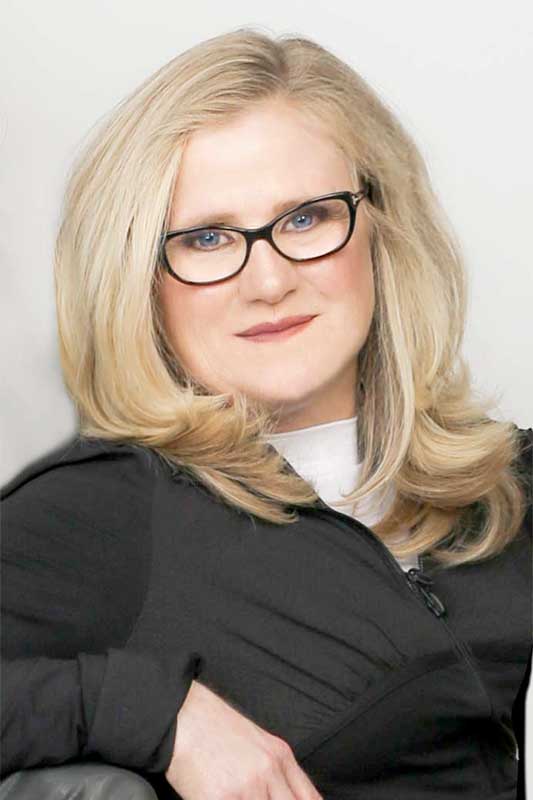
What you have done together with Taron [Lexton] all starts with the characters you’ve constructed, and yes, while part of this may be about your own journey in search of Fellini, I trust you didn’t enter into all of the antics that Lucy enters into?
[laughing] No.
But, what you have done in creating the characters is outstanding. All are so well-defined. We know each of these women, and even the men, and without the need for any dialogue, each is identifiable based on the whole package that’s been put together with costume, with the casting. One look at Ksenia [Solo], and she’s Lucy. The wide-eyed innocence, the waifishness, just pops from the screen, and you immediately know who this woman is. And the camera loves her. She is luminous.
Thank you. She does a magnificent job. I’ve seen it 28 times, and she’s like … I’m riveted. I can’t stop watching her.

How do you sit down and tackle a story like this, because one of the keys, not only in the character development, is the character interaction that we have, and especially that umbilical cord between Claire and Lucy across the miles? Did you structure that out while you were writing? Did you break this out like Lucy’s story first, Claire’s separate, and then interweave them?
That’s a good question. It was such an evolution. I don’t know how to describe it. It was a dance. It was like a choreography. Obviously, the editing had a lot to do with it, but no, the whole thing was written, and I took clips and little bits and pieces from Peter; I have to credit my co-writer, Peter Kjenaas. We must’ve written about a dozen scripts over the 20 years doing this, and it didn’t used to be mother/daughter. It was two friends, and another time it was sisters. We settled on the mother thing because I had realized late that let’s take the real incident that happened with my own mother, that my mother was dying when I was moving from California to come to Los Angeles to make my dream come true. When you take that and you have that in mind, this evolution, that’s how it evolved. The whole idea was her sending these postcards back and forth from her mother, so that was always there.
I love that connection, and it never breaks. That mother/daughter connection never breaks. You feel that from beginning to end. I wasn’t quite sure going in, because so much of this film, it feels like a Fellini. It feels like this is the ebb and flow of a Fellini film, where he examines, and he takes individuals on journeys and examines our own human condition and the idea of daring to dream. That is, in a nutshell, Fellini. That’s exactly what you have done here, and then Taron, with incredible cinematography by Kevin Garrison, just brings it all to life.
Oh, that’s awesome to hear you say that.
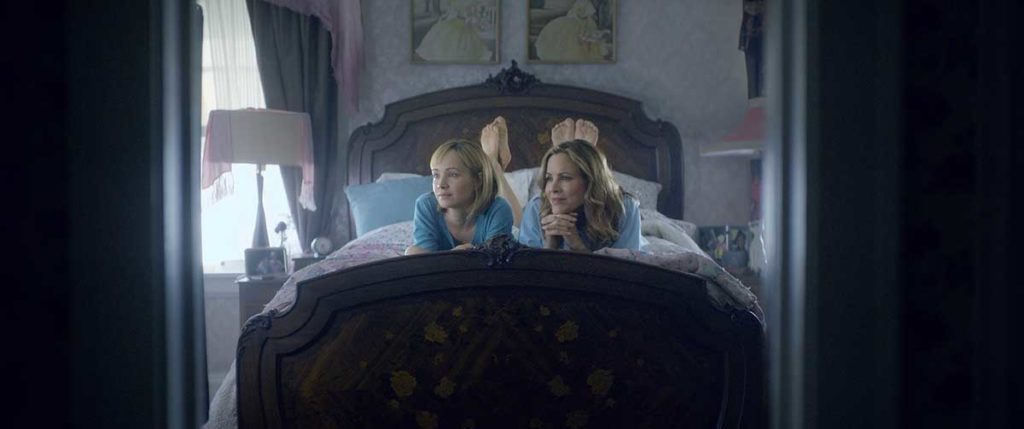
Did you have any idea at how visually impactful, how visually metaphoric and beautiful this film would be?
I have to be honest with you. I did have an idea, because of Taron. Taron, working with Kevin Garrison [cinematographer], the two of them together and the incredible relationship with Peter and myself. I wasn’t familiar with Kevin, and all the works that he had done, like commercials and things like that, but I was familiar with Taron. Taron brought Kevin in because of that. It’s just a way of saying that I just trusted so much in Taron, that it would look a certain way, but when I saw the first … It wasn’t even like saw the first screening of it. When we were on location, I could see it on the whatchamacallit, the monitor right there, that we could look at while they were shooting it. I’m like, ‘Oh, my god.’ I’ll tell you, part of that reason is, obviously, it’s the skill of Kevin Garrison, but the fact that we spent a million dollars on the lenses, because to do a film of this stature, it needed to have the backup and support technologically. When you have that technical expertise that’s established here, then whatever that message is that you’re trying to communicate can get to the audience.
Of course, you don’t go to a place like Italy with the locations that you guys are shooting and bring crappy equipment.
[laughing] That’s right. If I’m going to spend the money to get the crew and myself and the cast to Italy, I better be well-prepared.
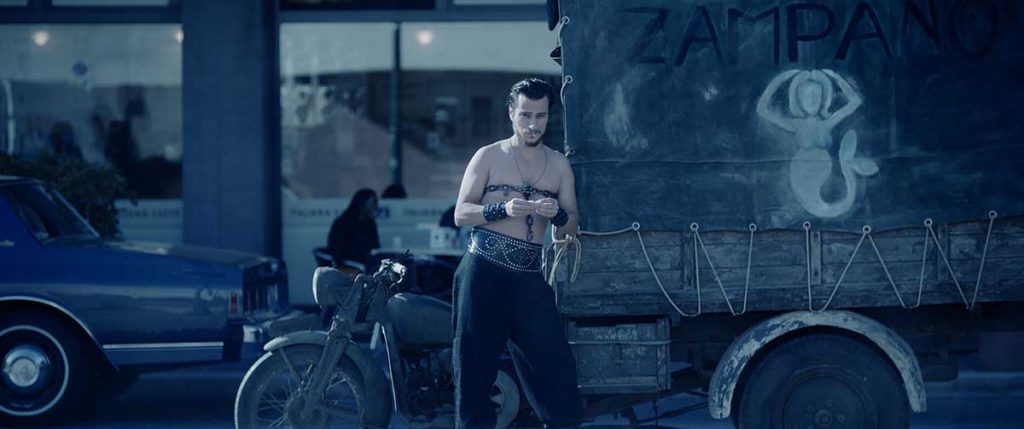
Because this is such a visual film, the aesthetic is so pure and so rich, when you were writing the script – and you know some writers do this – they put all the notes in the writing about the colors, how they’re envisioning this, how the costume is, etc. – and here, especially with Lucy and her costumes, there’s a simplicity and grounding to them that even in the most fantastical situations, she’s still the grounding element while all the fantasy is happening around her, I’m curious as to how specific you got within writing the script itself in terms of visual direction as to how you might see her standing by the fountain with the sun coming up and reflecting off her face or something like that.
Wow, you’re very observant! Thank you so much for that, but I can’t really take credit for that. When we wrote it, having her in this black and white [outfit], very simple, so that she’s taking this journey and as she’s going through the journey, things are shedding off of her so that she ends up in Rome where she lost her cape, she lost her bag. She had a hat at one time. The concept was always there that it’s kind of Fellini-esque, and kind of Harlequin-esque.

It’s so metaphoric for what Lucy is experiencing as she’s shedding all of this protection she’s had from her mother, and coming out on her own. It’s like each layer, each piece of clothing, each thing she loses is just a little bit more of her experiencing the world, and I just thought that that spoke so loudly as I was watching that.
Good. That’s so good to hear. You caught everything. Wow!
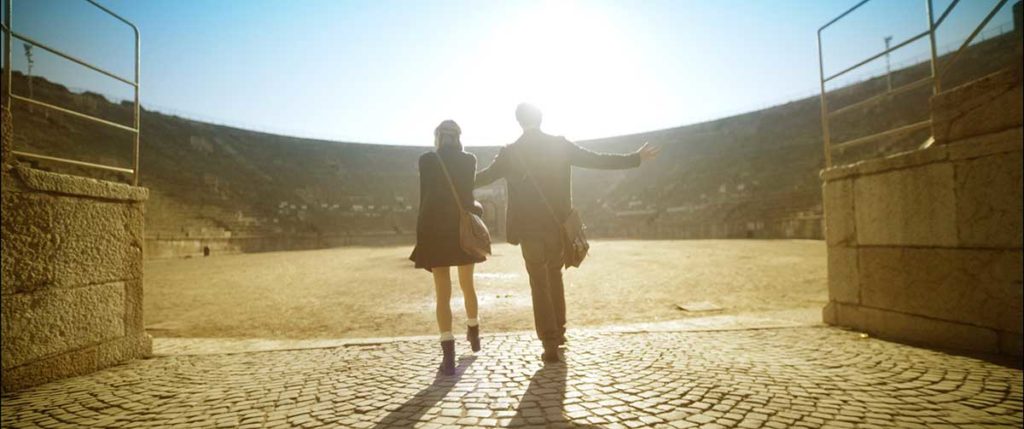
Was this cathartic for you in any way, going through this multi-year journey to bring this story to life?
Well, yeah, if only for the fact that it took so long that I finally did it. I’ve been talking about doing this for 20 years, and I always knew I was going to do it, but Debbie, I had to be ready for it. My responsibility had to be high enough that I knew that I could actually be an executive on this production and make sure that it got done the way that I wanted it to get done. Peter, having him as a writing partner, he was such a beacon for me, and I really looked towards him to help guide me because we had collaborated on the one-woman show. I didn’t write the one-woman show so that was using his help and guidance means that we could do this thing together.
I’m very curious, Nancy. Because of Bart Simpson, do you think there was ever a point that Bart was more of a hindrance or a help to you in your journey to IN SEARCH OF FELLINI?
You’re awesome! You are so awesome! Your questions are so compelling. Oh, my god! That’s an awesome question! I’m glad you asked me. You know what? The positioning of me with Bart, as a producer, is a good thing, but as an actress, it’s not a good thing. Honestly, for almost the entire development of it, I was going to be playing Claire as an actress, because I’m Claire’s age. Claire could be older. Maria Bello is younger than I am, but I could’ve easily played Claire. Nobody is going to tell Nancy Cartwright you can’t play this part.
But because it’s my integrity, it’s like I look at it and I go, ‘I see this is a hindrance. This is not good. I don’t want to …’ First of all, I don’t want it to be seen as a vanity production. I didn’t want it to be that way. I really wanted to just tell this story. Having Maria Bello, who as you saw, she’s so perfect for this part, and me step out because I don’t want the public thinking, first, it’s going to be an animated film, and, oh, if I did Claire, it would open up the door to criticism, like ‘She sounds like Bart Simpson’, and it would be distracting. So I’m like, ‘Forget it. I’m not doing it.’ It doesn’t mean that much to me. I’m not known as being an on-camera actress, even though I have some history in doing that.

I have to say, with the part that you do have as Cosima, I thought you were so charming, utterly charming in the role.
Thank you. I loved her. And I’m going to credit Taron for that because that part was originally a man. That’s real. That’s something that’s real. I did meet this guy and his name was Cosmo, and I’m Cosima. So we kept that similarity but there’s a little bit more to him than what I played and what we had time to play. It was adjusted a little bit, but he spoke seven languages and he worked with Fellini. He was an actor, and he was in “Satyricon”. And, so was, by the way, the guy that plays my husband in that one scene that I’m in. Bruno Zanin. When he was a young man, he was 22 at the time playing a 15-year-old and he lied and said he was 17, and he got the lead part in “Amarcord.” Yeah. We found him and pulled him out of retirement because he couldn’t make a living acting in Italy. We pulled him out and he was perfect.
Cosima’s scene is so beautiful. There’s real emotional resonance in your words, in the performance. And it came at a beautiful moment in the film.
Thank you. Thank you so much. Credit, again, is Taron and Spencer [Jones] and to the editors do it for doing this, and Taron’s guidance on that. It was such a collaborative art form. It just was so fulfilling. It was a charmed experience, I have to say. I loved it. Just every step of the way, and my staff that works with me at Spotted Cow, they kept any kind of upset off my lines, so that Peter and I and Taron could just focus. We were living in a little bubble, an Italian bubble, and any problems that they had with license agreements and shooting scenes that we had to pay to shoot in certain spaces in Italy, and all that stuff was kept off our lines. It was amazing.
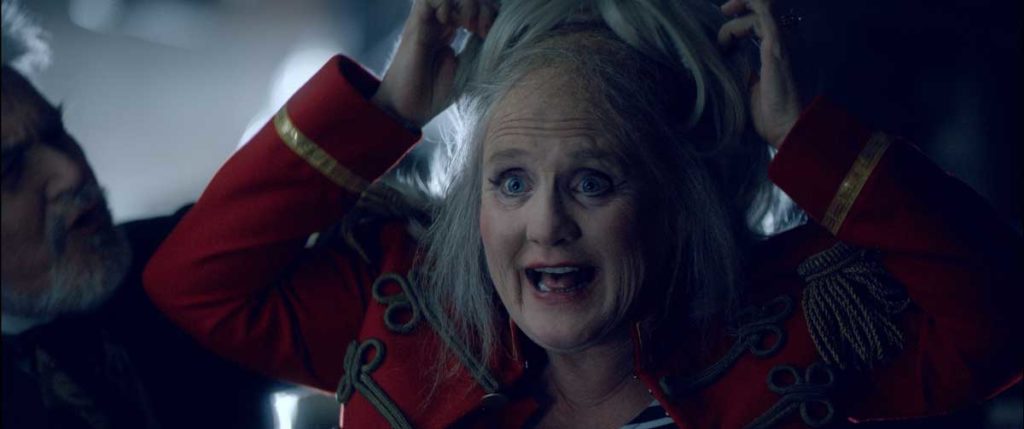
That’s a testament to the people that you hire, Nancy. That’s a good eye when you can find people like that and have them on your team, and then they protect you like that.
Absolutely. You got that right. It’s so important. It’s so important for artists to have people around them that they can actually trust and they’re not just yes-men. It also assures you that if you get a little too full of yourself, someone on your staff can take you aside and say, “You know what? Did you just hear what you just said?” If there’s that closeness in that relationship, and that trust, that kind of communication should be allowed to be said.
After now finally bringing this to life, and having it out there in the world, what did you learn about yourself in the process of making IN SEARCH OF FELLINI?
That’s an awesome question! In this journey, if you will, after the journey, I felt like I know that what I found for myself was that I can do anything. I can make any dream come true. I don’t mean to be glib about it. People can listen to Nancy Cartwright, the voice of Bart Simpson, been doing “The Simpsons” for 29 years, and she doesn’t have anything to worry about. She’s got a gazillion-million dollars. But it’s not about that. It’s about a confidence level in myself. It has to do with not letting other people crush my spirit. It’s not letting other people step in and make me feel small because as an artist, I can do anything. That really is the crux of it. We all have stories to tell. Everyone has a story to tell, and I have found that along my way. Even promoting the film, I took a cross-country trip.
I bought a 1952 classic Chevy pickup truck in Charlotte, North Carolina, just because I wanted to have one. My house is situated like a Connecticut farmhouse on one acre in Northridge, California. And I just felt like it was missing a truck from that era. It was just for fun and because I can. I wanted to have this as a toy. [laughing] We found this truck in Charlotte, and I drove it, or attempted to drive it across country. I was told it would make it, but it had a couple hiccups. The gas gauge wasn’t quite accurate. I became friends with AAA in several states. We recorded a lot of it, but the other part of the journey besides getting the truck home was interviewing people. I had three people with me with their iPhones and also with some really nice cameras to do these interviews of just interviewing people along Route 66. In Cracker Barrel Restaurants. We went through Springfield, Missouri, and Bentonville. We went to the Bentonville, Arkansas. There’s a film festival there that was one of our targets along the way. Here’s the deal – I met people. I did not tell them who I was. I said, ‘My name was Nancy, and I’m a filmmaker, and I’ve got a crew. I just want to ask you one question. We’re doing this documentary, and it’s not going to embarrass you. It’s thoughtful and thought-provoking. Could you answer a question for me?’ They’re like, “Yeah.” I didn’t get one person to say no.

Wow!
All I did was take the microphone, and I asked them, ‘So tell me something. What are you in search of?’ I’m telling you, Debbie, the reactions that I got, every single person, really, that’s a question that people just are thrown by. It’s amazing. We’re still working on the editing of it, and it’ll be released, probably on my website. But that, to me, was getting to the crux of my purpose in doing IN SEARCH OF FELLINI; was to hit that chord of reality that we all have in common, what is our purpose here. The stone, and you saw it in the “La Strada” clips, where Richard Basehardt gives her that little stone and says to her, “This stone has a purpose. Everything has a purpose, even you.” There you go.
by debbie elias, interview 09/12/2017












